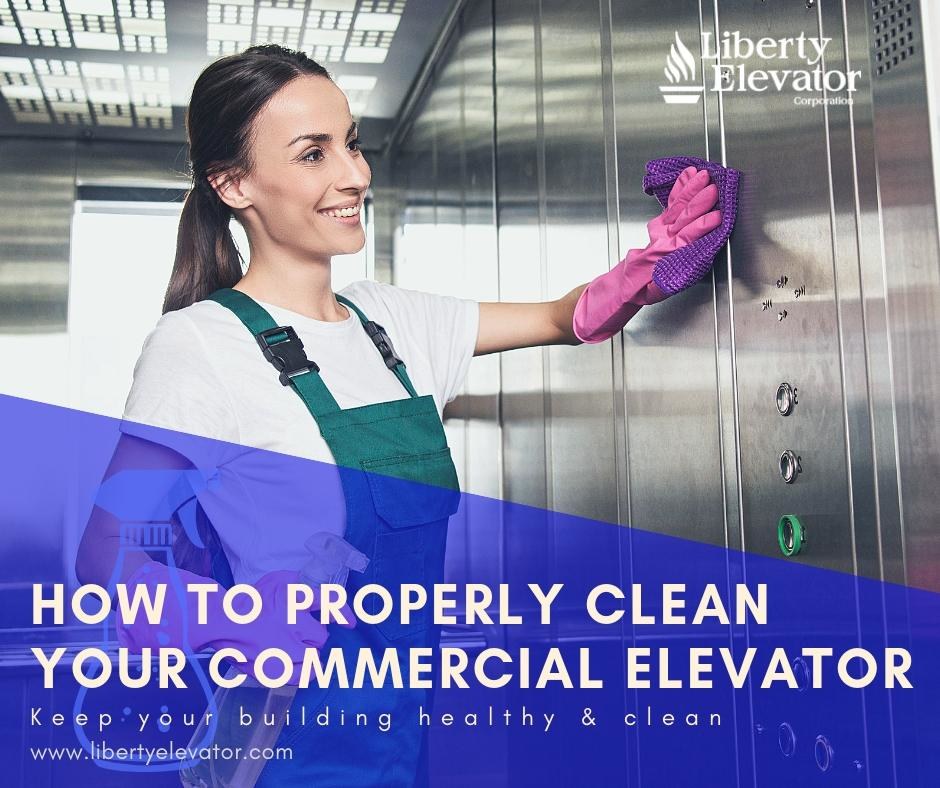Disinfect and Protect Your Elevator
Over the past two years, we have all been frantically cleaning every surface in our home, office and common spaces. In this mad rush to combat COVID-19 we may have been overlooking the long term damage that some common cleaning chemicals may have on components & surfaces. While disinfecting is priority one, you don’t want to inflict unnecessary damage to your electrical and mechanical devices that may result in costly repairs in the future.

Elevator Virus Protection & Cleaning Tips
Here are some basic cleaning practices that will keep your elevator healthy:
- Avoid using alcohol based cleaners directly on elevator buttons, as they may damage the lacquered surfaces and cause some plastic components to become brittle over time.
- For non-lacquered fixtures, you should use alcohol at the lowest concentration that will disinfect. For most elevator surfaces 70% alcohol solution is recommended.
- Using none abrasive, spray on cleaners with a disposable paper towel or microfiber cloth is recommended when wiping down your elevator.
- Spray cleaners should be applied to a clean rag or paper towel, then used to wipe down elevator buttons. Never spray cleaner directly on components.
- Sponges should be avoided as they may harbor bacteria and the excessive moisture may damage your elevator’s electronic components.
- We do not recommend bleach based solutions as they will react negatively with Polycarbonate fixtures.
- In general, for Non-Bleach disinfectants (ie: Lysol Wipes) we don’t have enough information about the specific chemicals that are the active disinfecting ingredients, so we would recommend abstaining from use.
Keep your elevator sterilized for virus protection
Is your commercial elevator being properly cleaned? Most commercial elevators feature stainless steel construction, an extremely durable metal that generally requires minimal upkeep. However, every elevator owner should know how to properly clean elevators to ensure safe operation and a clean environment for elevator passengers. Since so many people could use an elevator on any given day, routine thorough cleaning can help slow the spread of bacteria and disease.
Elevator owners should know the different vital sections of their commercial elevators and how to clean them correctly.
Cleaning the Elevator Sills and Tracks
The tracks between the sets of elevator doors at every landing in your building are ideal places for spills, dust, and debris to collect. Small particles like pieces of dirt, pine needles, or even small rocks can accumulate in elevator door treads. Use a vacuum device to remove large particles and dust, then use a non-abrasive cleaner to clean away the stainless steel. Be sure to get in between the cracks in the door treads and always ensure the elevator has completely stopped and lock it to prevent it from moving while cleaning door tracks.
Cleaning the Elevator Pit
Pit cleaning should never be attempted without a certified elevator technician present to assure proper lock out of the elevator. You may not expect to see trash in your elevator pit, but this is very common in many types of buildings. Trash, dust, and debris can fall through cracks between the elevator doors and accumulate in the pit below the elevator cab. Over time, this may interfere with the elevator’s moving parts. Remove trash and use a vacuum device to remove dust and dirt accumulation. Regular pit cleaning can also help prevent pest infestations that may enter the elevator pit to get at the fallen trash.
Sterilizing Elevator Doors and Walls
Most commercial elevators will have stainless steel walls and doors. Ensure the elevator has stopped completely and use a non-abrasive cleaner to remove dust and mess from stainless steel. You can also use specialized stainless steel cleaning agents to remove water spots and give stainless steel a clean and polished shine. When it’s time to clean the interior walls, use non-corrosive cleaners that do not leave behind strong smells; your elevator passengers will not enjoy a ride in a stuffy elevator with lingering cleaning agent smell.
Cleaning the Elevator Floors and Mirrors
Depending on the type of elevator floors you have, you may need to brush and vacuum carpeted floors or clean and polish tiled or steel floors. Again, non-abrasive and non-corrosive cleaners are the best options here. Many commercial elevators have low-rise carpeting that can trap dust, dirt, and grime, and a powerful cleaner can prevent passengers from tracking these things out of the elevator.
Cleaning Light Fixtures and Panel Buttons
To finish cleaning your elevator, the light fixtures and buttons on the control panel should come last. You can lock the elevator to prevent it from responding to accidental button presses. Use an antibacterial cleaning agent on the elevator buttons, being careful not to spray any cleaner directly on to the buttons that may seep inside the control panel and damage internal components. Use a microfiber cloth to clean the buttons and the panel, removing trapped dirt, dust, hair, and other bits stuck around the buttons. Microfiber cloths are also great for cleaning dust and dirt from light fixtures inside the elevator.
Avoid These Disinfecting Chemicals
When it comes to cleaning your elevator surfaces, including call buttons & touch screens, it is important to avoid the following chemicals that may be included in your current disinfectant solution:
| AVOID THESE CHEMICALS WHEN CLEANING YOUR ELEVATOR | |||
|---|---|---|---|
| Acetaldehyde | Calcium Bisulfite | Ethylene Oxide | Nickel Nitrate |
| Acetamide | Calcium Hydroxide | Ferrous Chloride | Nitric Acid (Concentrated) |
| Acetic Anhydride | Calcium Hydroxide | Fluorine | Nitrobenzene |
| Acetone | Calcium Hypochlorite | Furfural | Nitromethane |
| Acetyl Chloride (dry) | Carbolic Acid (Phenol) | Hexane | Oils: Cinnamon |
| Acetylene | Carbon Disulfide | Hydrazine | Oils: Orange |
| Acrylonitrile | Carbon Tetrachloride | Hydrochloric Acid 100% | Perchloroethylene |
| Amines | Chlorine, Anhydrous Liquid | Hydrochloric Acid 37% | Phenol (Carbolic Acid) |
| Ammonia 10% | Chloroacetic Acid | Hydrofluoric Acid 100% | Phosphoric Acid Anhydride |
| Ammonia, anhydrous | Chlorobenzene (Mono) | Hydrofluoric Acid 20% | Phosphorus Trichloride |
| Ammonia, liquid | Chloroform | Hydrofluoric Acid 50% | Picric Acid |
| Ammonium Hydroxide | Chlorosulfonic Acid | Hydrofluoric Acid 75% | Potassium Hydroxide (Caustic Potash) |
| Amyl Acetate | Chromic Acid 30% | Isopropyl Acetate | Propane (liquefied) |
| Aniline | Chromic Acid 50% | Isopropyl Ether | Pyridine |
| Aniline Hydrochloride | Copper Cyanide | Kerosene | Sodium Hydroxide (50%) |
| Aqua Regia (80% HCl, 20% HNO3) | Copper Nitrate | Ketones | Sodium Hydroxide (80%) |
| Asphalt | Cresols | Lacquers | Sodium Hypochlorite (<20%) |
| Barium Hydroxide | Cresylic Acid | Lithium Hydroxide | Sodium Sulfide |
| Barium Nitrate | Cyclohexanone | Lye: Ca(OH)2 Calcium Hydroxide | Sodium Thiosulfate (hypo) |
| Barium Sulfate | Diacetone Alcohol | Lye: KOH Potassium Hydroxide | Styrene |
| Benzaldehyde | Dichlorobenzene | Lye: NaOH Sodium Hydroxide | Sulfuric Acid (75-100%) |
| Benzene | Dichloroethane | Mercury | Sulfuric Acid (hot concentrated) |
| Benzene Sulfonic Acid | Diethyl Ether | Methyl Acetate | Tannic Acid |
| Benzol | Diethylamine | Methyl Butyl Ketone | Tetrachloroethylene |
| Bromine | Dimethyl Aniline | Methyl Cellosolve | Tetrahydrofuran |
| Butadiene | Dimethyl Formamide | Methyl Chloride | Toluene (Toluol) |
| Butane | Ethyl Acetate | Methyl Ethyl Ketone | Trichloroacetic Acid |
| Butyl Amine | Ethyl Benzoate | Methyl Isobutyl Ketone | Trichloroethane |
| Butyl Phthalate | Ethyl Chloride | Methyl Isopropyl Ketone | Turpentine |
| Butylacetate | Ethylene Bromide | Methylene Chloride | Urea |
| Butylene | Ethylene Chloride | Mineral Spirits | Xylene |
| Butyric Acid | Ethylene Chlorohydrin | Monochloroacetic acid | |
| Calcium Bisulfate | Ethylene Dichloride | Morpholine | |
Following these guidelines will reduce the risk of costly damage to your elevator and help to extend the life of your key elevator components. Although we cannot list every product to avoid, feel free to reach out to your Liberty Elevator representative or janitorial service with any cleaning questions or product recommendations.
Elevator Cleaning Services
If you are looking to bring in an outside cleaning company to manage your elevator cleaning, daily disinfecting or for a one time remediation of your entire property, our friends at PLANNED COMPANIES are the regional experts in janitorial services and understand your elevator's special requirements.
Liberty Elevator is here for you
As one of the top elevator companies in New Jersey, New York, Pennsylvania and Florida, Liberty Elevator understands that our customers have unique needs and offers our clients the freedom to choose.
Whether choosing a customized elevator maintenance program, installing nonproprietary equipment, or providing a flexible agreement, Liberty Elevator provides knowledgeable recommendations for various models and vintages of elevator equipment.
Learn more about our elevator virus protection, cleaning, and sterilization solutions, or contact Liberty Elevator today and start your elevator on the road to recovery.

